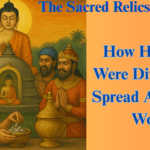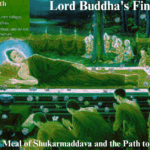
Table of Contents
Theravāda, Mahāyāna and Vajrayāna – The Heart of Buddhism Today
Theravāda, Mahāyāna and Vajrayāna
Buddhism, one of the world’s oldest spiritual traditions, has evolved into three major branches over the centuries — Theravāda, Mahāyāna, and Vajrayāna. Each of these schools offers a unique interpretation of the Buddha’s teachings while staying true to the core principles of compassion, mindfulness, and liberation from suffering. Even today, these three paths continue to form the living heart of Buddhism, guiding millions worldwide on their journey toward enlightenment.

1. Theravāda Buddhism – The Way of the Elders
Theravāda is considered the oldest and most conservative branch of Buddhism. It is widely practiced in countries like Sri Lanka, Thailand, Myanmar, Cambodia, and Laos.
Key Features:
- Scripture: Based on the Pāli Canon (Tipitaka), the earliest written record of the Buddha’s teachings.
- Goal: Achieving Arhatship — personal enlightenment and liberation from the cycle of birth and death (samsara).
- Monastic Focus: Emphasis on monastic life, meditation, ethical conduct (sīla), and wisdom (paññā).
- Meditation Practices: Vipassanā (insight meditation) and Samatha (calming the mind).
Theravāda is often seen as a path of introspection, discipline, and individual liberation, preserving the teachings in their most ancient form.
2. Mahāyāna Buddhism – The Great Vehicle
Mahāyāna Buddhism emerged around the 1st century CE and is dominant in China, Japan, Korea, Vietnam, and Taiwan. It offers a more inclusive path that emphasizes helping all beings achieve enlightenment.
Key Features:
- Goal: Becoming a Bodhisattva — one who postpones their own enlightenment to help others attain it.
- Scriptures: Includes both the Pāli Canon and newer texts like the Prajñāpāramitā Sūtras, Lotus Sūtra, and others.
- Compassion (Karunā) and Wisdom (Prajñā) are central virtues.
- Worship of Bodhisattvas: Such as Avalokiteśvara (compassion) and Mañjuśrī (wisdom).
Mahāyāna Buddhism promotes the universal liberation of all beings and encourages active engagement in the world with compassion.
3. Vajrayāna Buddhism – The Diamond Vehicle
Vajrayāna, also called Tantric or Esoteric Buddhism, developed from Mahāyāna and is mainly practiced in Tibet, Bhutan, Mongolia, and parts of Nepal and Russia. It is also the foundation of Tibetan Buddhism.
Key Features:
- Goal: Achieve enlightenment swiftly through powerful and advanced practices.
- Unique Practices:
- Mantras (sacred sounds)
- Mudras (ritual hand gestures)
- Mandala visualizations
- Guru devotion (importance of a spiritual teacher)
- Deity Yoga: Visualization of oneself as a deity to embody enlightened qualities.
Vajrayāna is known for its rich rituals, complex meditation techniques, and belief that enlightenment can be attained in a single lifetime.
Common Ground – Shared Essence of All Three Schools
Despite their differences, Theravāda, Mahāyāna, and Vajrayāna share essential teachings of the historical Buddha:
- The Four Noble Truths
- The Noble Eightfold Path
- Karma and Rebirth
- Impermanence, Suffering, and Non-Self
All three emphasize inner transformation, mindfulness, and ethical living as paths to awakening.
Why These Traditions Matter Today
In today’s fast-paced, uncertain world, the teachings of these Buddhist schools offer a timeless source of:
- Mental clarity
- Compassionate action
- Spiritual grounding
- Freedom from suffering
Whether through silent meditation, community service, or devotional practice, these traditions provide relevant tools to cultivate inner peace and global harmony.
Conclusion
Theravāda, Mahāyāna, and Vajrayāna are not just historical divisions — they are living traditions that continue to enrich spiritual life across cultures. Rooted in the teachings of the Buddha, each offers a unique yet interconnected path toward the same ultimate goal: liberation and awakening for all sentient beings. In their diversity, they reflect the universality of the Buddha’s message — one that continues to shine brightly in the hearts of millions.
Also Read This :
The Sacred Relics of Buddha: 8 Inspiring Ways His Ashes Were Divided and Spread Across the World
TheravadaBuddhism, #MahayanaBuddhism, #VajrayanaBuddhism, #TypesOfBuddhism, #BranchesOfBuddhism, #BuddhistTraditions, #BuddhismExplained, #BuddhistPhilosophy, #MindfulnessPractice, #BuddhistMeditation, #PathToEnlightenment, #BuddhistWisdom, #BuddhistTeachings, #BuddhismToday, #EasternPhilosophy, #BuddhaDharma, #PaliCanon, #BodhisattvaPath, #TibetanBuddhism, #SpiritualAwakening


